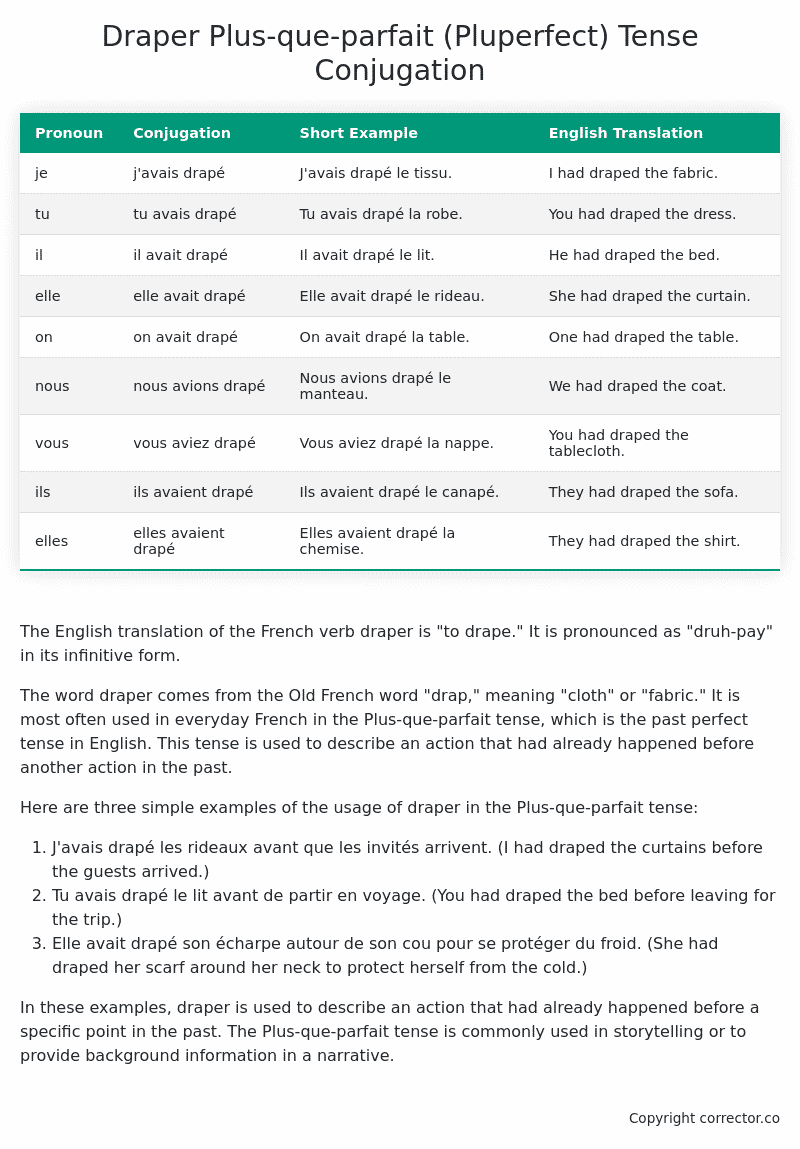Plus-que-parfait (Pluperfect) Tense Conjugation of the French Verb draper
Introduction to the verb draper
The English translation of the French verb draper is “to drape.” It is pronounced as “druh-pay” in its infinitive form.
The word draper comes from the Old French word “drap,” meaning “cloth” or “fabric.” It is most often used in everyday French in the Plus-que-parfait tense, which is the past perfect tense in English. This tense is used to describe an action that had already happened before another action in the past.
Here are three simple examples of the usage of draper in the Plus-que-parfait tense:
- J’avais drapé les rideaux avant que les invités arrivent. (I had draped the curtains before the guests arrived.)
- Tu avais drapé le lit avant de partir en voyage. (You had draped the bed before leaving for the trip.)
- Elle avait drapé son écharpe autour de son cou pour se protéger du froid. (She had draped her scarf around her neck to protect herself from the cold.)
In these examples, draper is used to describe an action that had already happened before a specific point in the past. The Plus-que-parfait tense is commonly used in storytelling or to provide background information in a narrative.
Table of the Plus-que-parfait (Pluperfect) Tense Conjugation of draper
| Pronoun | Conjugation | Short Example | English Translation |
|---|---|---|---|
| je | j’avais drapé | J’avais drapé le tissu. | I had draped the fabric. |
| tu | tu avais drapé | Tu avais drapé la robe. | You had draped the dress. |
| il | il avait drapé | Il avait drapé le lit. | He had draped the bed. |
| elle | elle avait drapé | Elle avait drapé le rideau. | She had draped the curtain. |
| on | on avait drapé | On avait drapé la table. | One had draped the table. |
| nous | nous avions drapé | Nous avions drapé le manteau. | We had draped the coat. |
| vous | vous aviez drapé | Vous aviez drapé la nappe. | You had draped the tablecloth. |
| ils | ils avaient drapé | Ils avaient drapé le canapé. | They had draped the sofa. |
| elles | elles avaient drapé | Elles avaient drapé la chemise. | They had draped the shirt. |
Other Conjugations for Draper.
Le Present (Present Tense) Conjugation of the French Verb draper
Imparfait (Imperfect) Tense Conjugation of the French Verb draper
Passé Simple (Simple Past) Tense Conjugation of the French Verb draper
Passé Composé (Present Perfect) Tense Conjugation of the French Verb draper
Futur Simple (Simple Future) Tense Conjugation of the French Verb draper
Futur Proche (Near Future) Tense Conjugation of the French Verb draper
Plus-que-parfait (Pluperfect) Tense Conjugation of the French Verb draper (this article)
Passé Antérieur (Past Anterior) Tense Conjugation of the French Verb draper
Futur Antérieur (Future Anterior) Tense Conjugation of the French Verb draper
Subjonctif Présent (Subjunctive Present) Tense Conjugation of the French Verb draper
Subjonctif Passé (Subjunctive Past) Tense Conjugation of the French Verb draper
Subjonctif Imparfait (Subjunctive Imperfect) Tense Conjugation of the French Verb draper
Subjonctif Plus-que-parfait (Subjunctive Pluperfect) Tense Conjugation of the French Verb draper
Conditionnel Présent (Conditional Present) Tense Conjugation of the French Verb draper
Conditionnel Passé (Conditional Past) Tense Conjugation of the French Verb draper
L’impératif Présent (Imperative Present) Tense Conjugation of the French Verb draper
L’infinitif Présent (Infinitive Present) Tense Conjugation of the French Verb draper
Struggling with French verbs or the language in general? Why not use our free French Grammar Checker – no registration required!
Get a FREE Download Study Sheet of this Conjugation 🔥
Simply right click the image below, click “save image” and get your free reference for the draper Plus-que-parfait tense conjugation!

Draper – About the French Plus-que-parfait (Pluperfect) Tense
Tense Formation
Common everyday usage patterns
Sequencing of past events
Background information
Hypothetical or reported speech
Interactions with other tenses
Summary
I hope you enjoyed this article on the verb draper. Still in a learning mood? Check out another TOTALLY random French verb conjugation!


